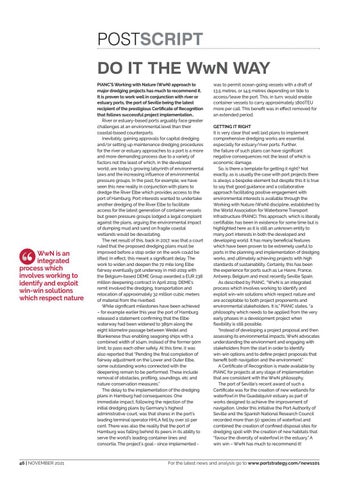POSTSCRIPT DO IT THE WwN WAY
‘‘
WwN is an integrated process which involves working to identify and exploit win-win solutions which respect nature
46 | NOVEMBER 2021
PIANC’S Working with Nature (WwN) approach to major dredging projects has much to recommend it. It is proven to work well in conjunction with river or estuary ports, the port of Seville being the latest recipient of the prestigious Certificate of Recognition that follows successful project implementation.. River or estuary-based ports arguably face greater challenges at an environmental level than their coastal-based counterparts. Inevitably, gaining approvals for capital dredging and/or setting up maintenance dredging procedures for the river or estuary approaches to a port is a more and more demanding process due to a variety of factors not the least of which, in the developed world, are today’s growing labyrinth of environmental laws and the increasing influence of environmental pressure groups. In the past, for example, we have seen this new reality in conjunction with plans to dredge the River Elbe which provides access to the port of Hamburg. Port interests wanted to undertake another dredging of the River Elbe to facilitate access for the latest generation of container vessels but green pressure groups lodged a legal complaint against the plans, arguing the environmental impact of dumping mud and sand on fragile coastal wetlands would be devastating. The net result of this, back in 2017, was that a court ruled that the proposed dredging plans must be improved before a stop order on the work could be lifted. In effect, this meant a significant delay. The work to widen and deepen the 72 mile long Elbe fairway eventually got underway in mid-2019 with the Belgium-based DEME Group awarded a EUR 238 million deepening contract in April 2019. DEME’s remit involved the dredging, transportation and relocation of approximately 32 million cubic meters of material from the riverbed. While significant milestones have been achieved – for example earlier this year the port of Hamburg released a statement confirming that the Elbe waterway had been widened to 385m along the eight kilometre passage between Wedel and Blankenese thus enabling seagoing ships with a combined width of 104m, instead of the former 90m limit, to pass each other safely. At this time, it was also reported that “Pending the final completion of fairway adjustment on the Lower and Outer Elbe, some outstanding works connected with the deepening remain to be performed. These include removal of obstacles, profiling, soundings, etc and nature conservation measures.” The delay to the implementation of the dredging plans in Hamburg had consequences. One immediate impact, following the rejection of the initial dredging plans by Germany’s highest administrative court, was that shares in the port’s leading terminal operator HHLA fell by over 10 per cent. There was also the reality that the port of Hamburg was falling behind its peers in its ability to serve the world’s leading container lines and consortia. The project’s goal - since implemented -
was to permit ocean-going vessels with a draft of 13.5 metres, or 14.5 metres depending on tide to access/leave the port. This, in turn, would enable container vessels to carry approximately 1800TEU more per call. This benefit was in effect removed for an extended period. GETTING IT RIGHT It is very clear that well laid plans to implement comprehensive dredging works are essential especially for estuary/river ports. Further, the failure of such plans can have significant negative consequences not the least of which is economic damage. So, is there a template for getting it right? Not exactly, as is usually the case with port projects there is always a bespoke element but despite this it is true to say that good guidance and a collaborative approach facilitating positive engagement with environmental interests is available through the Working with Nature (WwN) discipline, established by the World Association for Waterborne Transport Infrastructure (PIANC). This approach, which is literally certifiable, has been in existence for some time but is highlighted here as it is still an unknown entity to many port interests in both the developed and developing world. It has many beneficial features which have been proven to be extremely useful to ports in the planning and implementation of dredging works, and ultimately achieving projects with high standards of sustainability. Certainly, this has been the experience for ports such as Le Havre, France, Antwerp, Belgium and most recently Seville Spain. As described by PIANC, “WwN is an integrated process which involves working to identify and exploit win-win solutions which respect nature and are acceptable to both project proponents and environmental stakeholders. It is,” PIANC states, “a philosophy which needs to be applied from the very early phases in a development project when flexibility is still possible. “Instead of developing a project proposal and then assessing its environmental impacts, WwN advocates understanding the environment and engaging with stakeholders from the start in order to identify win-win options and to define project proposals that benefit both navigation and the environment.” A Certificate of Recognition is made available by PIANC for projects at any stage of implementation that are consistent with the WwN philosophy. The port of Seville’s recent award of such a Certificate was for the creation of new wetlands for waterfowl in the Guadalquivir estuary as part of works designed to achieve the improvement of navigation. Under this initiative the Port Authority of Seville and the Spanish National Research Council recorded more than 50 species of waterfowl and combined the creation of confined disposal sites for dredging spoil with the creation of new habitats that “favour the diversity of waterfowl in the estuary.” A win: win – WwN has much to recommend it!
For the latest news and analysis go to www.portstrategy.com/news101
















